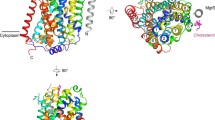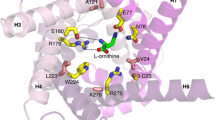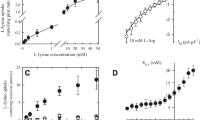Abstract
Cr3+, similar to Fe3+, is transported into cells primarily via endocytosis as the metal-transferrin complex. As Cr3+ ions are not readily reduced under biological conditions, the ion cannot be transported from endosomes by the same mechanism as iron that utilized divalent metal ion transporters. Cr3+ has been hypothesized to potentially be transported as small ligand complexes with a free carboxylate functionality by monocarboxylate transporters (MCT), in a similar fashion to that proposed for Al3+. Consequently, mouse C2C12 muscle cells were utilized to determine if Cr3+ is potentially transported by MCT by examining the effects of MCT inhibitors on Cr and Fe transport and subcellular distribution when the metals are added as their transferrin complexes. The results suggest that Cr is not primarily transported by MCT from the endosomes to the cytosol, and that another mechanism for this transport needs to be identified.


Similar content being viewed by others
References
Di Bona KR, Love S, Rhodes NR, McAdory D, Sinha SH, Kern N, Kent J, Strickland J, Wilson A, Beaird J, Ramage J, Rasco JF, Vincent JB (2011) Chromium is not an essential trace element for mammals: effects of a “low-chromium” diet. J Biol Inorg Chem 16:381–390
Vincent JB (2010) Chromium: celebrating 50 years as an essential element? Dalton Trans 39:3787–3794
Clodfelder BJ, Vincent JB (2005) Time-dependent transfer of chromium in adult rats from the bloodstream to the urine. J Biol Inorg Chem 10:383–393
Clodfelder BJ, Upchurch RG, Vincent JB (2004) A comparison of the insulin-sensitive transport of chromium in healthy and model diabetic rats. J Inorg Biochem 98:522–533
Clodfelder BJ, Emamaullee J, Hepburn DDD, Chakov NE, Nettles HS, Vincent JB (2001) The trail of chromium(III) from the blood to the urine: the roles of transferrin and chromodulin. J Biol Inorg Chem 6:608–617
Sun Y, Ramirez J, Woski SA, Vincent JB (2000) The binding of trivalent chromium to low-molecular-weight chromium-binding substance (LMWCr) and the transfer of chromium from transferrin and Cr(pic)3 to LMWCr. J Biol Inorg Chem 5:129–136
Dowling HJ, Offenbacher EG, Pi-Sunyer FX (1989) Absorption of inorganic, trivalent chromium from the vascularly perfused rat small intestine. J Nutr 119:1138–1145
Hopkins LL Jr, Schwarz K (1964) Chromium(III) binding to serum proteins, specifically siderophilin. Biochim Biophys Acta 90:484–491
Brock JH (1995) Transferrins. In: Harrison PM (ed) Metalloproteins, part 2. Verlag Chemie, Weinheim, pp 183–261
Ainscough EW, Brodie AM, Plowman JE, Bloor SJ, Sanders Loehr J, Loehr TM (1980) Studies on human lactoferrin by electron paramagnetic resonance, fluorescence, and resonance Raman spectroscopy. Biochemistry 19:4072–4079
Andrews NC (2008) Forging a field: the golden age of iron biology. Blood 112:219–230
Yokel RA, Allen DD, Ackley DC (1999) The distribution of aluminum into and out of the brain. J Inorg Biochem 76:127–132
Jackson VN, Halestrap AP (1996) The kinetics, substrate, and inhibitor specificity of the monocarboxylate (lactate) transporter of rat liver cells determined using the fluorescent pH indicator, 2,7′-bis(carboxyethyl)-5, (6)-carboxyfluorescein. J Biol Chem 271:861–868
Gerdom LE, Baenziger NA, Goff HM (1981) Crystal and molecular structure of a substitution-labile chromium(III) complex. Inorg Chem 20:1606–1609
Quiros M, Goodgame DM, Williams DJ (1992) Crystal structure of bispyridinium bis(citrate)chromium(III) tetrahydrate. Polyhedron 11:1343–1348
Hamada YZ, Carlson BL, Shank JT (2003) Potentiometric and UV-vis spectroscopy studies of citrate with the hexaquo Fe3+ and Cr3+ metal ions. Syn Reac Inorg Metal-org Chem 33:1425–1440
Ainscough EW, Brodie AM, Plowman JE (1979) The chromium, manganese, cobalt and copper complexes of human lactoferrin. Inorg Chim Acta 33:149–153
Lestas AN (1976) The effect of pH upon human transferrin: selective labeling of the two iron-binding sites. Br J Heamatol 32:341–350
de Duve C, Pressman BC, Gianetto R, Wattiaux R, Applemans F (1955) Tissue fractionation studies. 6. Intracellular distribution patterns of enzymes in rat-liver tissue. Biochem J 60:604–617
Rowin GL (1974) Isolation of lysosomes. Methods Mol Biol 5:89–109
Davis CM, Sumrall KH, Vincent JB (1996) The biologically active form of chromium may activate a membrane phosphotyrosine phosphatase (PTP). Biochemistry 35:12963–12969
Cooperstein SJ, Lazarow A (1951) A microspectrophotometric method for the determination of cytochrome oxidase. J Biol Chem 209:665–670
Zhang ZY, Van Etten RL (1991) Pre-steady-state and steady-state kinetic analysis of the low molecular weight phosphotyrosyl protein phosphatase from bovine heart. J Biol Chem 266:1516–1525
Hajduch E, Heyes RR, Watt PW, Hundal HS (2000) Lactate transport in adipocytes: identification of monocarboxylate transporter MCT1. FEBS Lett 479:89–92
Juel C, Halestrap AP (1999) Lactate transport in skeletal muscle: role and regulation of the monocarboxylate transporter. J Physiol 517:633–642
Rink K, Ghigo E, Kalaidzidis Y, Zerial M (2005) Rab conversion as a mechanism of progression from early to late endosomes. Cell 122:735–749
Jin Y, Crichton RR (1987) Iron transfer from transferrin to transferrin. FEBS Lett 215:41–46
Rehncrona S, Hauge NH, Siesjo BK (1989) Enhancement of iron-catalyzed free radical formation by acidosis in brain homogenates: Difference in effect by lactic acid and CO2. J Cereb Flow Metab 9:65–70
Kornfeld S (1969) The effect of metal attachment to human apotransferrin on its binding to reticulocytes. Biochim Biophys Acta 194:25–33
Acknowledgments
This work was supported by the National Research Initiative grant 2009-35200-05200 from the USDA Cooperative State, Research, Educational, and Extension Service to JBV and JFR. Kristin R. Di Bona assisted in working out conditions for the cell homogenization.
Conflict of interest
The authors have no conflicts of interest to declare.
Author information
Authors and Affiliations
Corresponding author
Rights and permissions
About this article
Cite this article
Rhodes, N.R., LeBlanc, P.A., Rasco, J.F. et al. Monocarboxylate Transporters are not Responsible for Cr3+ Transport from Endosomes. Biol Trace Elem Res 148, 409–414 (2012). https://doi.org/10.1007/s12011-012-9381-1
Received:
Accepted:
Published:
Issue Date:
DOI: https://doi.org/10.1007/s12011-012-9381-1




